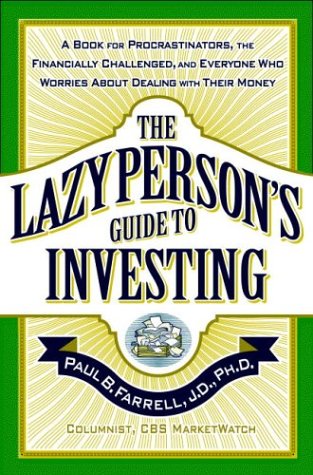| ............. |
This article was posted on March 1, 2004. Being a "lazy person" myself, I was very interested in reading CBS MarketWatch columnist Paul Farrell's book The Lazy Person's Guide to Investing. It's among the best on the subject that I've read in recent years. Investing doesn't have to be hard work. Indeed, the people who spend little time thinking about their savings often outperform those that do. Farrell starts off with a review of three "lazy portfolios"; Dallas Morning News columnist Scott Burns' two-asset class Couch Potato Portfolio, Bill Schultheis's seven-asset class Coffeehouse Portfolio, and author William J. Bernstein's four-asset class No-Brainer Portfolio. Each of these portfolios make full use of the concepts of diversification and modern portfolio theory (MPT) yet only require somewhere between 5 minutes and one hour per year to manage. Farrell helpfully shows how to construct each of these "lazy portfoios" with low-fee Vanguard mutual funds. Next the author moves to a discussion of market timing and asset allocation. As Farrell says, asset allocation wins and market timing loses. The sixth chapter "Frugal Savings Wins" demonstrates that managing your living expenses is as important as maximizing your investment returns. Farrell recounts an illustrative story from one of the attendees at Berkshire Hathaway's annual shareholder's meeting, perhaps the largest gathering of multi-millionaires in America.
Expense ratio is the only reliable predictor of mutual fund performance This is perhaps the most important point in the book and one that is little understood by investors. The less your mutual fund manager takes in fees and commissions, the more that's left for you. That's why low-fee index funds are the choice of many Nobel Laureates in Economics for their personal investment portfolios. Dilbert's one-page book on financial planning Farrell mentions two significant contributions by Scott Adams -- the creator of the comic strip Dilbert. The first is Dilbert's one-page book on financial planning -- a nine-point "to-do" list that covers 95% of what most people need to know about personal finance. The second is Dilbert's "Dollar-to-Weasel Ratio" which explains much of the corruption and misbehavior we see on Wall Street and in the mutual fund industry. Dilbert postulates that whenever a certain number of dollars is collected in one place, a weasel magically appears to take some or all of it.
The Lazy Person's Guide to Investingby Paul B. FarrellWarner Business Books, New York , January 2004, 352 pages. Click here to order The Lazy Person's Guide to Investing Today! Retire Early rating: Perhaps the most startling revelation of the book was mutual fund manager Ted Aronson's personal investment portfolio. While Aronson runs $7 billion of other people's money in actively managed pension funds, his own money is in low-fee Vanguard index funds. As author Farrell points out, "actively managed mutual funds are guaranteed to underperform the indexes due to unnecessary loads, excessively high expenses, trading costs, and extra taxes." The last two chapters of the book cover the new field of "neuroeconomics", the marriage of brain science and economics. Researchers have been studying how brain chemistry and personality affect one's financial decision making. Farrell describes how controlling emotions is helpful in managing your finances. In fact, Farrell's previous book The Millionaire Code - 16 Paths to Wealth Building used the 16 personality types of the Myers-Briggs Type Indicator to explain the differences in how, and if, people become wealthy. It, too, is highly recommended. The conversational tone of The Lazy Person's Guide to Investing makes it easy to follow and understand. The real life examples of how several prominent financial celebrities manage their own money brings the book to life. People leary of math will appreciate the fact that it doesn't contain any complex equations. Even readers well-grounded in the finer points of asset allocation and modern portfolio theory (MPT) are likely to pick up a few useful anecdotes on how Nobel Prize winners invest their money. |
![[Retire Early]](retire.gif)


![[Retire Early]](ademail.jpg)